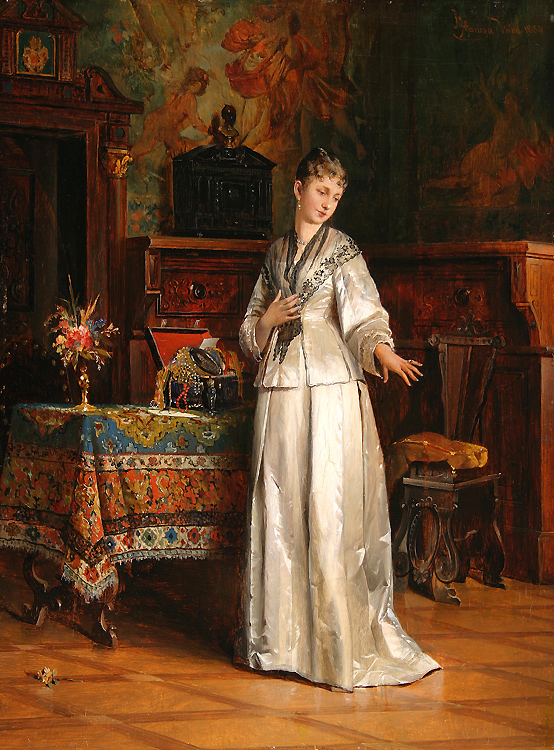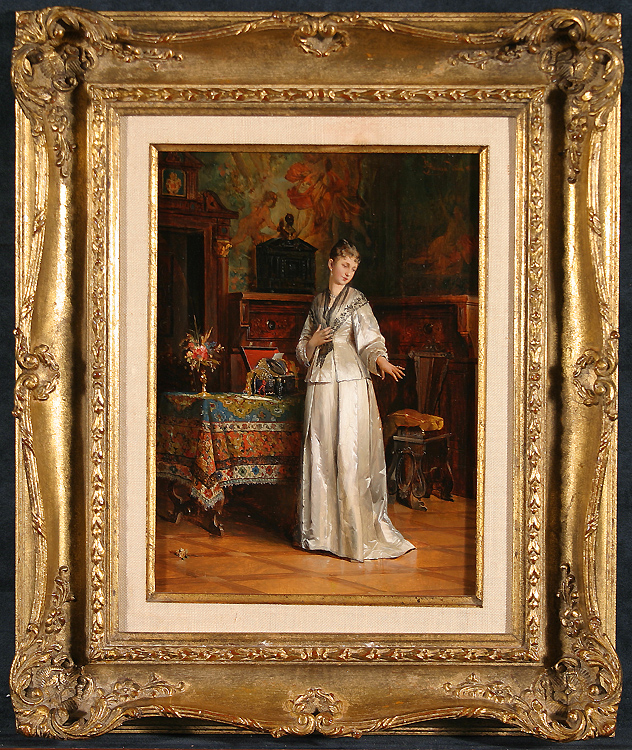Johann Hamza
(1850 - 1927)
The Family Heirloom
Oil on panel
9 5/8 x 7 inches
Signed, inscribed and dated 1880
BIOGRAPHY - Johann Hamza (1850 - 1927)
Despite the progressive trends of late nineteenth century art in Vienna, many artists favored a more traditional approach to painting and subject matter consistent with their Academic training and one that would appeal to their bourgeois patrons. Artists throughout Europe, including Johann Hamza, preferred to look to the past for inspiration, producing fanciful images of an aristocratic society that recalled eighteenth century masters. Clearly this was not a localized phenomenon and the sheer proliferation of artists working in this type of genre painting throughout Europe signal that these images were in high demand from patrons and continue to command admirable prices even today.
Given that art historical studies have in the past, and somewhat less so today, generally tended to favor the study of arts in France and England at the expense of other areas of production, there is still much to learn about Viennese creation and the work of Hamza. What scant details are available tell us that he was born on June 21st in Teltsch, now located in the southern region of the modern day Czech Republic, but then part of the vast Hapsburg Empire.
Vienna, however, was the cultural, artistic, and economic center of the Empire, and it was here that Hamza undertook his artistic training in the imperially-organized Academy of Fine Arts, which attracted artists from across the Hapsburg lands. During the late 1870s and towards the end of the century, the Academy in Vienna was organized so that students would complete their training in the General Painting School before applying to study with one professor who specialized in a certain genre of painting. It is likely that Hamza was enrolled in the Academy during this period and that he followed this course, eventually coming under the tutelage of Edward von Engerth. Toward the end of the nineteenth century, however, the Academy system disintegrated under the pressure from groups such as the Viennese Secession who began their own form of modern art by moving away from Academic traditions in 1897.
Given Vienna’s position as a financial and industrial center in addition to being a cultural oasis, it was home to a number of financiers, industrialists, and merchants who were eager patrons of the arts. Some must have been attracted to Hamza’s rendering of luxurious interiors, featuring, perhaps, the revival style furniture that was a popular commodity for nineteenth century consumers. His paintings were usually of a very small, and thus intimate format, suitable for their introduction into the home. He was clearly indebted to his training at the Academy in Vienna in his execution but introduced a personal element in his choice of subject matter – a revival of eighteenth century styles. In his paintings, his interest in depicting the most minute detail coupled with a sensitive study of facial features and characteristics provides a sympathetic tone to his work. His work recreates the life, styles, etiquette, luxury, and setting of the previous century in all of its glory, as nineteenth century audiences looked back on their predecessors with romantic enthrallment. He excelled at recreating detailed interior settings, as in many of his paintings, the focus is equally drawn to the exquisite and sumptuous display of furniture, objets d’art, and interior decorative detailing found on the walls of apartments. The fanciful works by Hamza that are set in contemporary settings, nevertheless reflect his interest in the art of a bygone era. These works were not produced solely for the pleasure of patrons, however, as Hamza was an active exhibitor at several exhibitions in the artistic centers of Central and Northern Europe. Hamza’s paintings were shown in Vienna, Munich, and Dresden between 1879 and 1890. He also exhibited in London in 1891 where he was given a Gold Medal.
Hamza died December 22nd, 1927 in Vienna. Hamza’s son, Hans, continued his father’s artistic tradition and often created market scenes and detailed architectural representations, perhaps learning the sense exactitude for his paintings from his father.
While we have little information at this point about Hamza’s life, modern day audiences may still appreciate his precise rendering and creation of detailed environments that offer viewers a sense of the potential reconstruction of the past.


